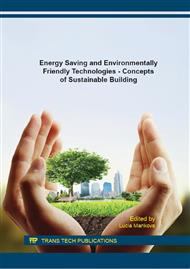p.124
p.132
p.140
p.148
p.156
p.164
p.172
p.180
p.188
The Influence of Additional Insulation of Facades to their Aesthetic Devaluation by Vegetation of Algae, Fungi and Cyanobacteria
Abstract:
The purpose of the facade insulation is to reduce transmission heat loss from the heated interior to exterior. After some time, it can be said that the insulation of the building envelope served its purpose and significantly reduce heat use for heating of insulated buildings. Time, however, showed the risks of external thermal insulation composite system (ETICS). One side effect of reducing transmission heat loss of buildings by using of ETICS can be considerable aesthetic devaluation of facades. Sometimes façade with ETICS become a suitable substrate for the growth of microorganisms. These are algae, fungi and cyanobacteria, which creates unsightly green and black growths on facades. The article deals with the connection between thermal insulation of external walls and the presence of vegetation microorganisms.
Info:
Periodical:
Pages:
156-163
Citation:
Online since:
January 2016
Authors:
Keywords:
Price:
Сopyright:
© 2016 Trans Tech Publications Ltd. All Rights Reserved
Share:
Citation:


